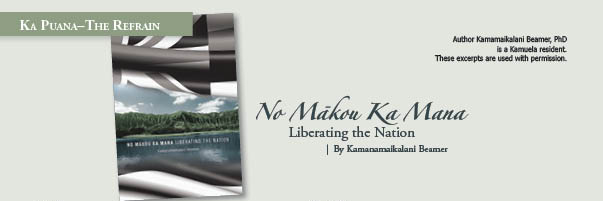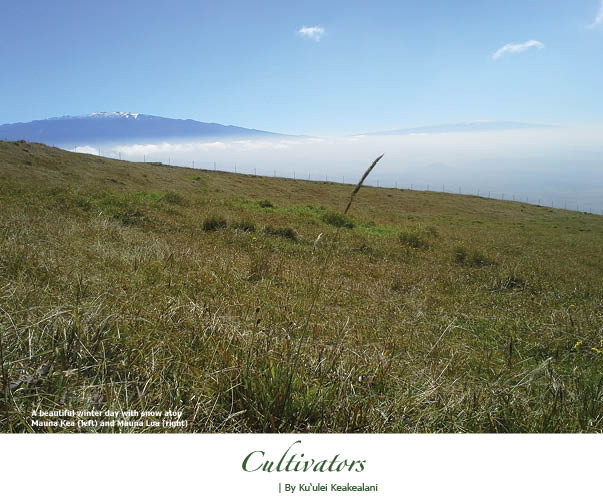
No Mākou Ka Mana: Liberating the Nation
 Page 3
Page 3
Recognizing the complex identity of ali‘i such as Lili‘uokalani is an important part of this study; however, the examples of how the ali‘i exercised their agency are perhaps of greater significance for contemporary ‘Oiwi (Native Hawaiian)5 and other indigenous people. This book does not suggest that one should live like and make the same decisions as the ali‘i; rather, it discusses what can be learned from how the ali‘i confronted their challenges.
This study builds on three related themes: (1) how a group of Hawaiian ali‘i confronted Europeans and Americans to form a nation-state in the nineteenth century, (2) how natives exercised their agency even while Hawaiian nationalism began to decline following the illegal overthrow of the Hawaiian Kingdom government in 1893, and (3) how ‘Oiwi today can be emboldened by gaining a better understanding of the wisdom of our ali‘i and the choices they made to benefit the lāhui.
The essential argument of this book is that ali‘i selectively appropriated Euro-American tools of governance while modifying existing indigenous structure to create a hybrid nation-state as a means to resist colonialism and to protect Native Hawaiian and national interests. Essentially, I am saying that ali‘i took what they wanted to use from the Euro-American world while maintaining their identity as ali‘i and Hawaiians.
5 See, for example, Trask, Native Daughter; Kame‘eleihiwa, Native Land; Osorio, Dismembering Lāhui; and Silva, Aloha Betrayed.
Page 5
This book offers a new framework for viewing and understanding Hawaiian history, leaders, and lands. It offers a new perspective of Hawaiian leadership and the creation of the Hawaiian Kingdom. It places the ali‘i at the center of the narrative while examining critical moments of their reigns as they grappled with Euro-American imperialism. As ali‘i forged the nation and held on to critical pieces of an ‘Oiwi past, they formed a country. The Hawaiian Kingdom—recognized as an independent state in 1843 and acknowledged as a member of the family of nations—was a country built on a foundation of both indigenous Hawaiian and modified Euro-American principles to protect Hawaiian national interests.
Later, in 1893, US officials and a small oligarchy of lawyers and businessmen overthrew the Hawaiian Kingdom precisely because it successfully safeguarded Hawaiian interests. The overthrow was not a culmination of a sustained set of colonizing events that began with James Cook’s arrival in the islands; rather, it was a critical assault on indigenous Hawaiian governance and the beginning of the US occupation of the Hawaiian Islands.
Page 194
One frequently overlooked reason for American involvement in the overthrow was that the Reciprocity Treaty of 1887—and thus the exclusive use of Pearl Harbor by the United States—was set to expire in 1894. On November 20, 1892, British Consul Wodehouse wrote, “Up to the present time no steps have been taken by the U.S. government to render Pearl Harbor available for U.S. warships.”11 Overthrowing the constitutional Hawaiian Kingdom government in 1893 allowed Pearl Harbor to be developed by the US military without interference or oversight from the Hawaiian Kingdom government.
11 Wodehouse, Correspondence, November 20, 1892.
Page 195
‘Oiwi Opposition to Annexation
Groups of Hawaiian nationals mobilized to defeat the proposed treaty. Hawaiian historian Noenoe Silva has written extensively on the astute diplomacy of Queen Lili‘uokalani, the Hui Kālai‘āina, and the Hui Aloha ‘Āina in demonstrating the Hawaiian population’s disapproval of this treaty.13 The two hui conducted large-scale petition drives, collecting the signatures of nearly forty thousand Hawaiian nationals who opposed annexation. The hui and the queen were successful. The treaty of annexation was never passed in the US Congress because it was not able to attract a two-thirds majority.
Still, the US administration pursued annexation of Hawai‘i and resorted to a domestic joint resolution in 1898, known as the “Newlands Resolution.” To this day, it remains unclear how the United States annexed a foreign country through a domestic joint resolution, since a domestic resolution is not a treaty, and its jurisdiction is within the nation-state. The legality of this action therefore continues to be debated by academics, Hawaiian organizations, and legal experts.14
13 Silva, Aloha Betrayed
14 Sai, “American Occupation . . . A Century Unchecked.” See also Coffman, Nation Within and Sai, “The American Occupation.” In a related vein, some historians may argue that Texas was acquired through joint resolution, but in fact it was acquired through the treaty of Guadalupe Hidalgo.
Contact author Kamanamaikalani Beamer
No Mākou Ka Mana is available from the author and local bookstores.


